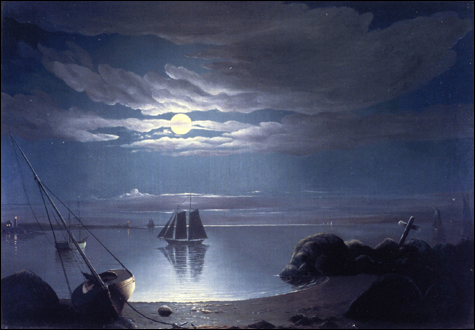Wilmerding declined to speak to me on this matter, but he did answer some questions via letter. He response: “When I first looked at the signature on the Sweepstakes, I said it was unmistakably in Lane’s hand, but being such an anomaly, I had no explanation for it (not thinking of the obvious!).”
Lane (1804–1865) was an uneven artist, but at his best he painted bustling harbors, rocky shores, and great open skies suffused with a curious stillness, like frozen memories. What stands out is his attention to the way light breaks through clouds and falls on sails and waves. The Western Shore with Norman’s Woe (circa 1862) is an arrestingly calm depiction of a glassy smooth low tide lapping against a curve of rocky Gloucester beach under pink fluffy clouds. Mary Blood Mellen (1819–1886) struggles to keep up. Their differences are palpable in the Cape Ann show. Lane is generally crisper, more specific. Mellen is mushier and softer; her paint tends to be a bit thicker. His rigging is precise; hers is suggested. His boats float convincingly in the water; hers sit unnaturally high. Some of the pairings — like a rough Lane oil sketch of a Gloucester island next to Mellen’s finished painting — exaggerate Lane’s weaknesses and Mellen’s strengths.

MOONLIGHT, GLOUCESTER HARBOR: Redolent of Caspar David Friedrich, this is Mary Blood
Mellen at her best.
|
Mellen’s mysterious Moonlight, Gloucester Harbor (1870s), which seems to be an original composition, is better than Lane’s nearby paintings on the same theme. A schooner, in silhouetted profile, glides into the night harbor. A beached boat sits in the foreground, near a cross sticking out of seaweedy rocks. A full moon peeks from behind swooping clouds, which are rendered flatly, like stage props. Here Mellen’s technique is distinguished by a folksiness that feels charming, vulnerable, human. But mostly she comes off as a copyist, with little evidence here that she did much original. It’s unclear whether this is a full picture.
Because Wilmerding has long been the authoritative source on Lane, it’s his work that much of the new information is correcting. James Craig began studying Lane in 2004 — he was preparing to give lectures that July at the Cape Ann Historical Museum, where he was then a curator. “And when I was reading up on him, things weren’t clicking.”
Craig checked Wilmerding’s source for the statement that Lane’s ancestors “were among the first settlers of Gloucester in 1623”; what the book actually said, he discovered, was that the first Lane to come to Gloucester wasn’t born till a generation later. Then there was Wilmerding’s statement about the boy Lane that, “disliking his name, he had it changed to Fitz Hugh as soon as he was able.” Craig says this never made sense to him, and indeed, Gloucester’s archives committee learned that Lane didn’t change his name to Fitz Henry till he was in his late 20s. Fitz H. Lane also argues that there’s no record to support Wilmerding’s report of the grammar school Lane attended, and no reason to believe Wilmerding’s assertion that the design for Lane’s Gloucester home was inspired by Nathaniel Hawthorne’s The House of Seven Gables, a book that wasn’t published until a year after Lane moved in. The Salem house that inspired Hawthorne had, Craig adds, just three gables during Lane’s lifetime.
There are also questions of attribution. A painting of a steamship, “Unicorn” in Salem Harbor, is described by Wilmerding as one of Lane’s earliest known oils. Craig detects stylistic discrepancies, and he notes that between the 1970s, when it was advertised for sale, and 2000, when it was also offered, conservation appears to have taken place: smoke has disappeared from the boat’s stack and a suspiciously Dutch (and thus un-Lane) leeboard has appeared on the side of a second boat.
Craig isn’t the only one finding mistakes. Drawing on the diaries of Lane’s patron Samuel Sawyer, Wilmerding wrote that French artist Rosa Bonheur visited Sawyer in Gloucester in 1861, and that, Sawyer noted, she “presented me with a large and beautiful Bull Calf.” Mary Rhinelander McCarl, a volunteer at the Cape Ann Historical Museum who has been transcribing the diaries, tells me that Sawyer was actually writing about his Jersey cow, which he’d named after Bonheur.
In 2003, the Cape Ann Historical Museum acquired a pair of portraits that were attributed to Lane and said to depict Joseph Stevens and his wife. Wilmerding had written to a previous owner: “Short of a firsthand look the portrait does indeed seem to be from Lane’s hand. While it is cruder than his familiar marine scenes, it is very much like the few known portraits that he did do.” But a photo of Stevens has turned up that doesn’t resemble the man in the painting. And infrared scans by Cleveland Museum of Art conservator Marcia Steele find “very minimal, if any underdrawing.” Lane usually made “extensive underdrawing in his paintings. He was meticulous.” This doesn’t prove that the portraits aren’t by Lane — perhaps he used a different technique for his rare portraits — but it raises doubts.